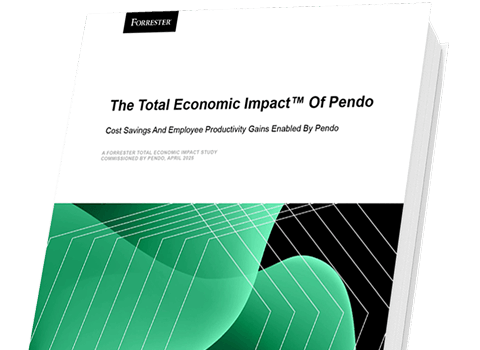
Pendo vs. Amplitude: How do they compare?
Amplitude tells you what happened. Pendo tells you why AND what's next.

The Total Economic Impact of Pendo
01 Accelerate impact and adoption with the only purpose-built, all-in-one platform
Amplitude provides powerful analytics to understand what users are doing, but lacks qualitative feedback, leaving teams struggling to act on those insights.
Pendo is a unified platform that helps you not only understand behavior with analytics and feedback but also influence it directly with integrated omnichannel messaging.
Teams drive innovation and product adoption at scale without engineering dependencies, reducing time-to-value compared to fragmented solutions requiring multiple vendors.
02 Optimize experiences by engaging users across the entire journey
Amplitude gives you insights but no proven way to turn them into action. Their recent acquisition of CommandAI is still unproven and lacks the deep integration with analytics that Pendo has perfected over a decade. You're left piecing together disjointed tools instead of working in one seamless platform.
Pendo is the only platform designed to engage users throughout their journey with embedded guides, cross-platform resource centers, NPS surveys, and targeted email campaigns — all informed by rich behavioral data.
By integrating Pendo's analytics and in-app guides, Okta achieved a 25% increase in product adoption and a 57% quarter-over-quarter rise in user-submitted feature ideas. This empowered their product team to make data-driven decisions, enhance user engagement, and streamline the product experience.
03 Built for everyone, not just analysts
Despite its appealing Ul, Amplitude requires complex configurations and technical expertise for implementation, creating bottlenecks and slowing time-to-insight.
Pendo offers intuitive, no-code capabilities for all teams including low-code analytics, visual guide editor, session replay with deeper platform integrations, and pre-built dashboard templates.
Product, marketing, customer success, and sales teams can all create, deploy, and measure in-app initiatives without technical resources — reducing time-to-implementation.


By empowering the product team with data, giving product managers the ability to build in-app guides and segmentation in Pendo, iRobot was able to decrease time to production by 50% and cut down engineering effort by 75%—freeing up critical resources to build new functionality, launch new features, and sizzle down tech debt.
04 Future-proof your software experience strategy
As an analytics platform, Amplitude primarily serves technical teams and analysts, and has only recently begun expanding into areas like session replay and in-app guidance with early-stage capabilities. Meanwhile, their recent acquisition raises questions about long-term strategic direction and product priorities.
Pendo provides a comprehensive platform designed for every team that shapes the software experience — product, customer success, support, IT, marketing and operations — with mature capabilities developed over a decade. With its founders still at the helm, Pendo maintains consistent vision and roadmap stability that customers can trust.
Organizations achieve cross-functional alignment and consistent user experiences across the entire software lifecycle, becoming integrated into nearly every corner of the business. Companies using Pendo realized a 396% ROI by overcoming the limitations of tools like Amplitude that failed to provide easy user behavior tracking and meaningful data collection. Real customers report that Pendo now forms the backbone of their efforts to improve customer health, drive feature adoption, and boost retention across departments.
Pendo vs. Amplitude:
Key Capabilities Comparison
What your business needs


Understanding user behavior
Complete picture with product analytics, session replay, and qualitative feedback in one platform
Strong product analytics but missing integrated qualitative feedback and user engagement capabilities
Acting on insights
Native in-app guides, resource centers, and email campaigns allow immediate action on insights without developer resources
Requires integration with other tools or custom development to act on insights
Getting started quickly
No-code installation and intuitive UI for all teams with time-to-value in days or weeks
Complex implementation requiring technical resources and event planning with longer time-to-value
Cross-team collaboration
Single platform for product, customer success, marketing, sales and support teams with unified access and reporting
Primarily designed for technical teams with limited utility for other departments
Measuring business impact
Closed-loop reporting shows direct impact of in-app engagement on adoption, retention and growth
Analytics-only approach makes it difficult to measure the impact of actions taken to improve metrics
Why companies switch from Amplitude to Pendo
UX Director, Technology
Join THE PENDO Community
More than just a vendor
Collaborez avec d'autres experts Pendo en personne et virtuellement, connectez-vous avec vos pairs dans un espace de travail Slack dédié et amplifiez votre impact avec Pendo.
Pendomonium X
Unforgettable one-day events where you’ll get inspired by top thinkers across software, connect with your peers, and learn how to lead your company in the age of AI.
Mind the Product
Learn from product experts and become part of the world’s most engaged community for product managers
->
Groupes d'utilisateurs Pendo
Rencontrez-vous en personne ou virtuellement pour vous connecter avec vos pairs, échanger les meilleures pratiques et découvrir tous les trucs et astuces de Pendo.
Académie Pendo
Découvrez des cours à la demande et des formations pratiques pour approfondir vos connaissances et maximiser la valeur.
Ready to see the real thing?
Schedule a demo to see how Pendo can replace and enhance your Amplitude implementation.
Foire aux questions
With Pendo you get time to value in minutes — not months. As soon as Pendo is installed on your application, it starts collecting data. You can tag a page or feature anytime, and Pendo automatically surfaces all relevant data back to the time of installation.
Amplitude has recently added Guides and Surveys, but their qualitative capabilities remain fairly limited.
Pendo offers a much more mature and integrated approach to qualitative insights, combining tools like Listen, NPS/Surveys, and AI-driven sentiment analysis to help teams understand not just what users are doing, but why.
By seamlessly connecting feedback with behavioral data, Pendo makes it easier to diagnose friction points, prioritize improvements, and drive better adoption—at both the user and account level.
Amplitude gives you the “what.” Pendo gives you the full story.
Yes. As a result of their 2024 acquisition of CommandAI, Amplitude released in-app guide messaging in early 2025, which are still in their infancy.
Pendo has always believed that product analytics that help companies understand what their customers are doing within their product and in-app guides to help them act on that data go hand-in-hand. But in addition to pop-up overlay guides like Amplitude offers, Pendo allows users to embed guides directly into their product experience, so they can drive higher adoption, engagement, and self-sufficiency—without disrupting the user journey.
Yes, Pendo and Amplitude both allow for historical data to be captured with low-code tools. While Amplitude has historically pushed for code tracking only, they’ve recently added their own form of autocapture, reflecting a market shift toward what Pendo has always believed–low-code, retroactive analytics helps teams move faster.
Pendo can store data for up to seven years allowing for a powerful low-code approach for retroactive analytics and support for custom event tracking, so you can get the insights you need, when you need them. We’ve always believed that teams shouldn’t have to choose between fast insights and flexibility—that’s why retroactive analytics has been core to Pendo from the start. Read more about retroactive analytics here.
Pendo turns insights into action, immediately. With built-in in-app guides, messaging, surveys, and email, teams can engage users from the same platform where they analyze behavior—no developer support or third-party tools required.
Amplitude requires integration with external systems or engineering support to close the loop on insights, slowing down execution and adoption.
Pendo replaces multiple point solutions,combining product analytics, session replay, in-app guidance, feedback collection, sentiment analysis, and roadmap communications in one platform.
Amplitude only offers product analytics, forcing you to undergo costly, time-consuming integrations with additional tools to support user engagement and feedback management.
Yes. Pendo is a no-code platform with a snippet or browser extension install. . That means teams—from product to IT and Revenue—can build and launch guides on their own, and push them live in days.
Amplitude typically requires complex event planning, technical resources, and ongoing developer involvement—leading to longer ramp time and slower ROI.
Pendo delivers comprehensive qualitative insights via integrated NPS, in-app surveys, email, and AI-driven sentiment analysis. Connected with Product Analytics and Session Replay, this allows teams to understand not just what users do—but why.
Amplitude has only recently begun exploring qualitative features, and is limited in its ability to capture and act on user feedback without moving to another platform.
Pendo In-app Guides are more advanced, integrated with qual and quant insights, and scalable.
Pendo In-app Guides are even more powerful thanks to real-time segmentation based on behavioral data. Teams can launch targeted onboarding flows, announcements, walkthroughs, and tooltips with no code—directly from the same platform they use to analyze product usage. Features like embedded guides, performance analytics and deep customization help drive user adoption and self-service at scale.
Amplitude’s guides, added on in 2024 after acquiring a guides provider, are still in their infancy. Users experience a clunky creation experience that forces them to bounce back and forth between building steps in the Amplitude UI, and the product URL, to design content at each step. Amplitude guides also don’t support embedded content, a no-code UI modification tool unique to Pendo, and users have to install a separate SDK to preview and launch guides. This fragmented process slows teams down, makes iteration challenging, and prevents non-technical users from taking advantage of Amplitude.
Pendo is built to support cross-functional collaboration across product, marketing, customer success, and support teams. Its no-code, all-in-one platform helps every role act on insights and drive user engagement independently—without relying on engineering or juggling multiple tools.
Amplitude, on the other hand, is primarily built for data and engineering teams. Its steep learning curve, manual instrumentation, and lack of integrated engagement tools limit user adoption and impact for non-technical stakeholders.
Pendo delivers closed-loop reporting that ties in-app user behavior directly to business outcomes like adoption, retention, and expansion. Our platform doesn't just show what happened—it helps you understand why, and gives you the tools to act on those insights instantly.
Amplitude, while strong in analytics, doesn’t have cross-channel communications and feedback management capabilities. That means that when teams make changes based on Amplitude data, they often struggle to connect those actions to outcomes. Without native in-app guides or qualitative feedback tied to behavioral cohorts, Amplitude leaves visibility gaps that make it harder—and more costly—to drive and measure real product impact.






